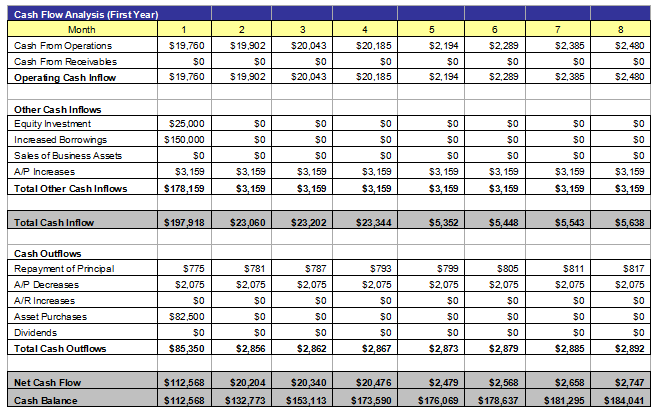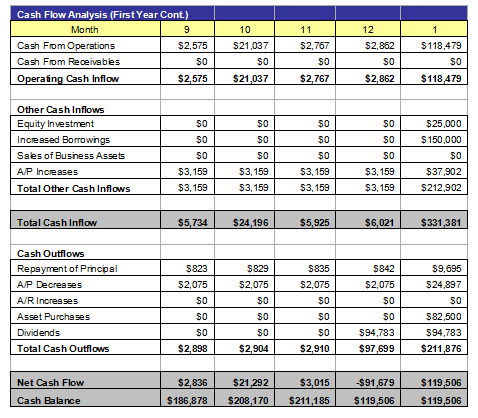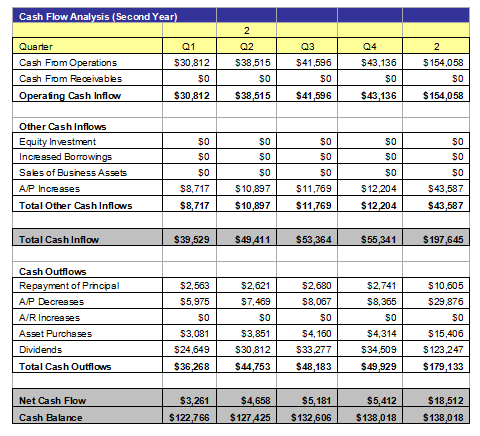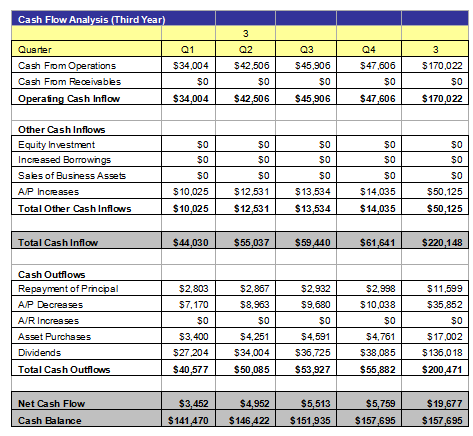Free Loan Brokerage Business Plan
For Raising Capital from Investors, Banks, or Grant Companies!
Please note that the financials
in this complete free business plan are completely fictitious and may not
match the text of the business plan below. This free business plan demonstration
purposes only. If you are interested in purchasing the completed editable MS Word
and Excel documents for this business plan, please click the button below! Also,
the text of the business plan is formatted with a fully automated
table of contents.
Return to
Samples Page
It should be noted that there is no special software required to use these
templates. All business plans come in Microsoft Word and Microsoft Excel format.
Each business plan features:
- Excecutive Summary
- Company and Financing Summary
- Products and Services Overview
- Strategic Analysis with current research!
- Marketing Plan
- Personnel Plan
- 3 Year Advanced Financial Plan
- Expanded Financial Plan with Monthly Financials
- Loan Amortization and ROI Tools
- FREE PowerPoint Presentation for Banks, Investors,
or Grant Companies!
1.0 Executive Summary
The purpose of this business plan is to raise $100,000 for the development of a commercial loan brokerage while showcasing the expected financials and operations over the next three years. Loan Brokerage, Inc. (“the Company”) is a New York based corporation that will provide SBA and commercial loan/lease brokering and services to customers in its targeted market. The Company was founded by John Doe.
1.1 Products and Services
The primary revenue center for the Loan Brokerage will come from the ongoing loan packaging, and loan closing services on behalf of commercial borrowing clients that are based in New York. All services will be provided on a contingency basis with very modest fees (ranging from $50 to $200) charged upfront as they related to verifying the credit and financial information provided by a prospective client. The third section of the business plan will further discuss the services offered by the Loan Brokerage.
1.2 The Financing
Mr. Doe is seeking to raise $100,000 from an investor. The terms, dividend payouts, and aspects of the deal are to be determined at negotiation. This business plan assumes that an investor will receive 50% of the Company’s stock, a regular stream of dividends, and a seat on the board of directors. The financing will be used for the following: • Development of the Company’s office. • Financing for the first six months of operation. • Capital to purchase a company vehicle.
1.3 Mission Statement
The Loan Brokerage’s mission is to become the recognized leader in its targeted market for business loan and commercial mortgage brokering services.
1.4 Mangement Team
The Company was founded by John Doe. Mr. Doe has more than 10 years of experience in the commercial financing industry. Through his expertise, he will be able to bring the operations of the business to profitability within its first year of operations.
1.5 Sales Forecasts
Mr. Doe expects a strong rate of growth at the start of operations. Below are the expected financials over the next three years.
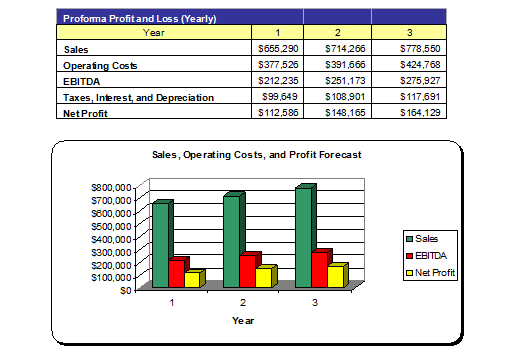
1.6 Expansion Plan
The Founder expects that the business will aggressively expand during the first three years of operation. As the economic markets return to normal conditions, the Loan Brokerage will be an excellent position to capture a significant portion of its targeted market.
2.0 Company and Financing Summary
2.1 Registered Name and Corporate Structure
Loan Brokerage, Inc. The Company is registered as a corporation in the State of New York.
2.2 Required Funds
At this time, the Loan Brokerage requires $100,000 of investor funds. Below is a breakdown of how these funds will be used:
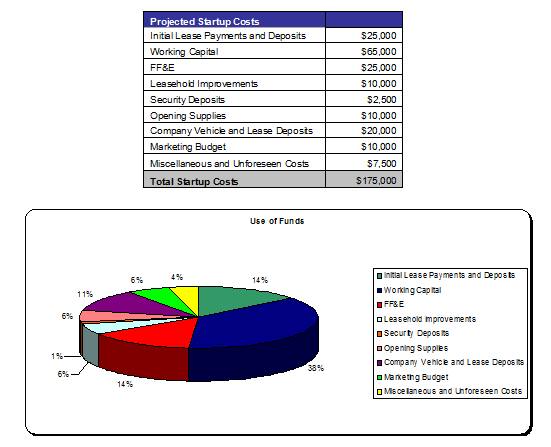
2.3 Investor Equity
John Doe intends to sell 50% of the Loan Brokerage in exchange for the capital.
2.4 Management Equity
John Doe will retain 50% of the business once the capital is raised.
2.5 Exit Strategy
If the Loan Brokerage is very successful, Mr. Doe may seek to sell the business to a third party for a significant earnings multiple. Most likely, the Company will hire a qualified business broker to sell the business on behalf of the Loan Brokerage. Based on historical numbers, the business could fetch a sales premium of up to 4 times earnings.
3.0 Products and Services
Below is a description of the services offered by the Loan Brokerage.
3.1 Business Financing
The primary revenue center of the Loan Brokerage is the financing of business loans and commercial financing solutions through nationally recognized lenders in the United States. Within this unit, the business will offer the following lending products: • Traditional Business Loans • Traditional Business Lines of Credit • Franchise Financing • Accounts Receivable Financing (Potential Secondary Source of Income) • Equipment Leasing Financing (Potential Secondary Source of Income) The anticipated fees related to this aspect of the Loan Brokerage’s operations will generate fees equal to 2.7% of the face value of the commercial loan acquired on behalf of a client.
3.2 Commercial Mortgage Financing
The other primary revenue generating business unit of Loan Brokerage will be the brokered lending of mortgage funds for commercial real estate transactions. For each transaction, the business will receive an anticipated commission of 1.5% to 2% of the face value of each commercial mortgage closed on the behalf of the business. As time progresses, the business may obtain a warehouse line of credit that it may use to close commercial mortgages in its own name. This will allow the business to almost double the profitability of this business unit as commercial mortgage bankers (as opposed to mortgage brokers) have the ability to charge both the borrower a closing fee in addition to receiving service release premiums from the divestiture of closed mortgages that are on the Loan Brokerage’s warehouse line of credit.
4.0 Strategic and Market Analysis
4.1 Economic Outlook
Mortgage brokerages have exploded with growth over the last ten years. As interest rates decreased, and the overall value of properties skyrocketed, the number of agents in this market has more than tripled. However, the industry has been pummeled in the last two years with the fallout of the mortgage market. Currently, the economic market condition in the United States is moderate. The meltdown of the sub prime mortgage market coupled with increasing gas prices has led many people to believe that the US is on the cusp of a double dip economic recession. This slowdown in the economy has also greatly impacted real estate sales, which has halted to historical lows.
4.2 Industry Analysis
In the United States there are over 60,000 businesses that operate as non-depository credit institutions including originators of loans, mortgages, and leases. Among these businesses, aggregate receipts over each of the last five years have been in excess of $800 billion dollars of revenue. These businesses employ over 500,000 people and provide gross annual payrolls in excess of $220 billion dollars. Specifically, the leasing industry provides $300 billion of financing for businesses seeking to purchase capital equipment. Approximately half of all capital equipment expenditures are financed with leases. The Internet has revolutionized the way that many loan brokers and lenders do business. It is not uncommon for financing originators, like this business, to lend among a broad geographical base and to a wide variety of clients that have varying incomes and credit qualities. Additionally, since the Internet has created a method of receiving information at a much faster rate, information relating to the credit quality of borrowers is readily available.
4.3 Customer Profile
Management has determined that the following demographics will be used when targeting potential clients that will use the business’ services in regards to business planning and commercial financing brokering: • Has an average annual income in excess of $75,000. • Lives or operates a business within Pennsylvania, New Jersey, or New York (at the onset of operations). • Is seeking to borrow an average amount of $300,000. • Has a FICO score in excess of 700 (among the three major credit bureaus). • Is prepared to make a capital infusion of 10% to 20% of the face value of the entire transaction for the business venture they are starting or is seeking to expand.
4.4 Competitive Analysis
This is one of the sections of the business plan that you must write completely on your own. The key to writing a strong competitive analysis is that you do your research on the local competition. Find out who your competitors are by searching online directories and searching in your local Yellow Pages. If there are a number of competitors in the same industry (meaning that it is not feasible to describe each one) then showcase the number of businesses that compete with you, and why your business will provide customers with service/products that are of better quality or less expensive than your competition.
5.0 Marketing Plan
The Loan Brokerage intends to maintain an extensive marketing campaign that will ensure maximum visibility for the business in its targeted market. Below is an overview of the marketing strategies and objectives of the Loan Brokerage.
5.1 Marketing Objectives
5.2 Marketing Strategies
Commercial financing marketing will be the most difficult portion of the marketing strategy. This is because one of the essential elements to reaching this audience is that the Company must build a brand affinity with the customer. This task will be accomplished through the business’s broad marketing campaign throughout its targeted market. The Loan Brokerage will also use an internet based strategy. This is very important as many people seeking SBA/Commercial Loans use the Internet to conduct their preliminary searches. Mr. Doe will register the Loan Brokerage and its agents with these online portals so that potential buyers can easily reach the business. The Company will also develop its own online website showcasing current interest rates, the Management Team, and the commercial lending services offered by the business. The Company will maintain a sizable amount of print and traditional advertising methods within local markets to promote the services that the Company is selling.
5.3 Pricing
In this section, describe the pricing of your services and products. You should provide as much information as possible about your pricing as possible in this section. However, if you have hundreds of items, condense your product list categorically. This section of the business plan should not span more than 1 page.
6.0 Organizational Plan and Personnel Summary
6.1 Corporate Organization
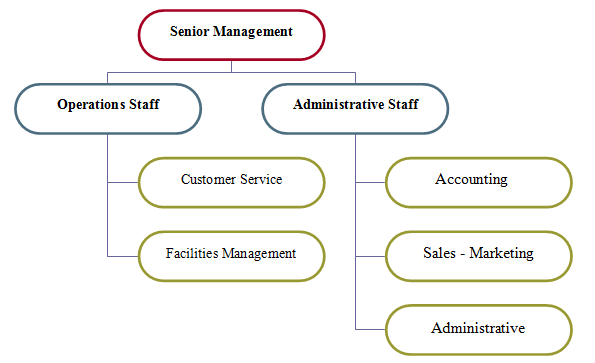
6.2 Organizational Budget
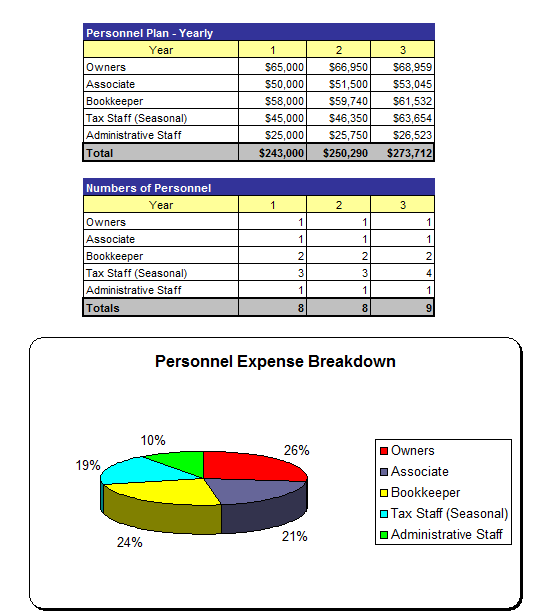
6.3 Management Biographies
In this section of the business plan, you should write a two to four paragraph biography
about your work experience, your education, and your skill set. For each owner or
key employee, you should provide a brief biography in this section.
7.0 Financial Plan
7.1 Underlying Assumptions
-
• Loan Brokerage will have an annual revenue growth rate of 18% per year.
-
• Mr. Doe will acquire $100,000 of investor funds to develop the business.
-
• The business will not seek debt financing in the first three years of operations.
7.2 Sensitivity Analysis
The Company’s revenues can change depending on the general economic climate of the real estate industry. In times of economic recession, the Loan Brokerage may have issues with its top line income as fewer business and commercial property sales will be made.
7.3 Source of Funds
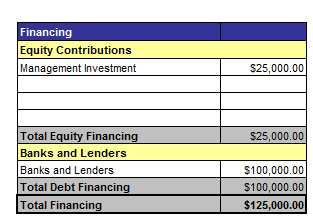
7.4 General Assumptions
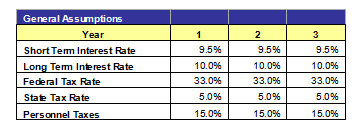
7.5 Profit and Loss Statements
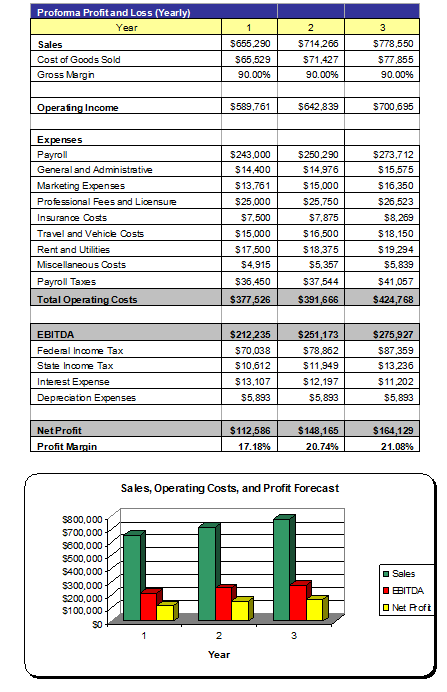
7.6 Cash Flow Analysis
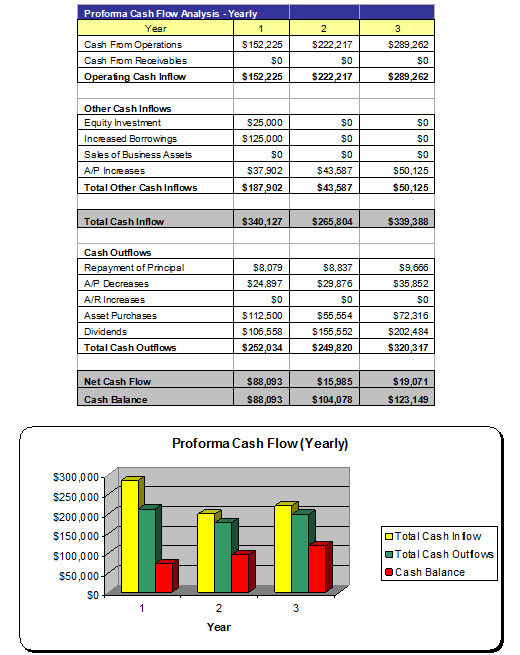
7.7 Balance Sheet
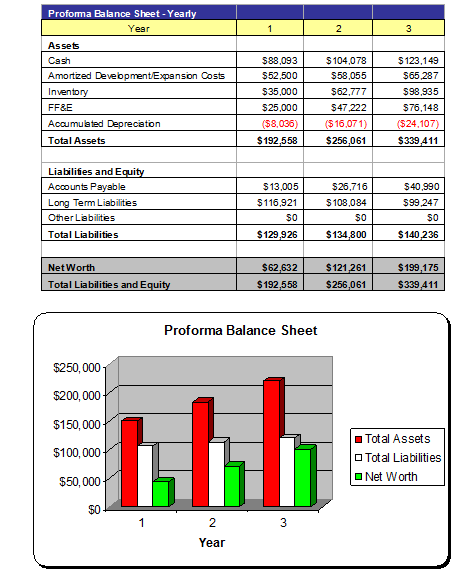 .
.
7.8 General Assumptions
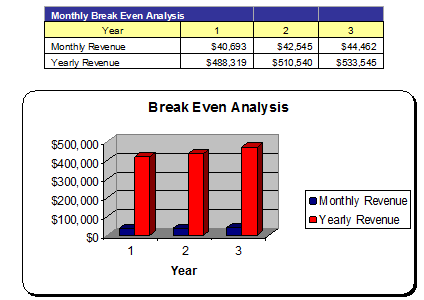
7.9 Business Ratios

Expanded Profit and Loss Statements
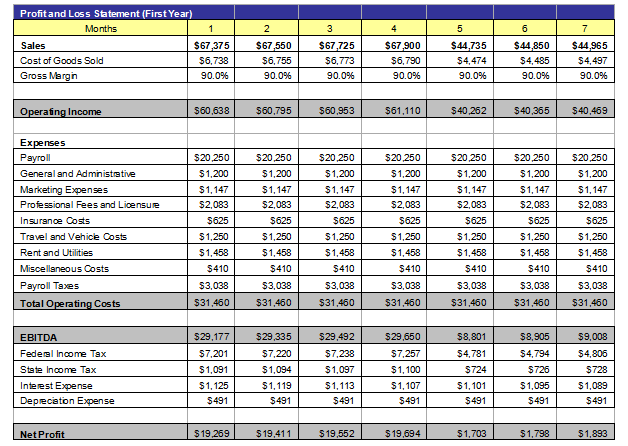
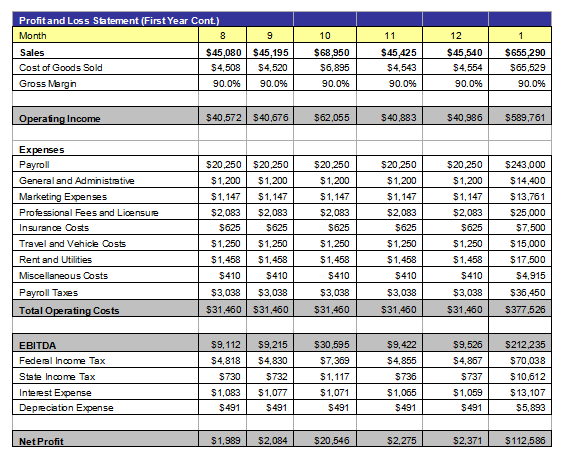
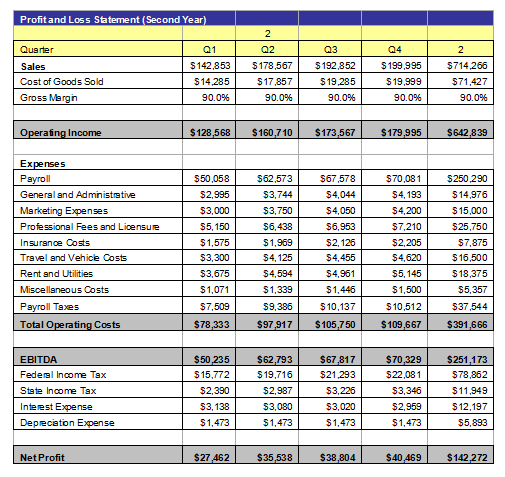
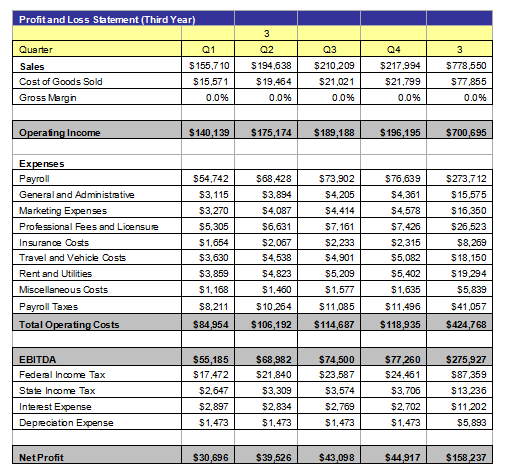
Expanded Cash Flow Analysis
